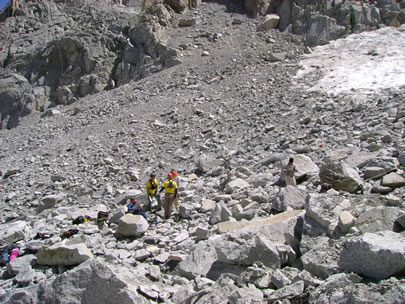 |
|
|
SEQUOIA & KINGS CANYON NATIONAL PARKS Body of World War II Airman Found In Park [Printer-friendly text version]
Hikers discovered what are believed to the remains of a WWII airman killed in a 1942 plane crash in a remote part of Kings Canyon on the afternoon of August 17th. The discovery has been the focus of international media coverage. Rangers received the report of the discovery from hikers who found the remains while exploring in the Mt. Mendel area. Due to the remoteness of and difficulty in reaching the area, a park archeologist and rangers were flown to a point near the site the morning of August 18th. They located the remains and began investigating and documenting the scene. The remains were removed and flown out of the backcountry, then transferred to the Fresno County Coroner’s Office. In 2005, the body of a military airman was found in Mendel Glacier. Evidence collected at the time included World War II era equipment. Among those items was an undeployed parachute with the words “US ARMY” stenciled on the pack. The airman, later identified as Leo Mustonen, was a cadet on a military plane that crashed with four men on board during a training exercise in 1942. Rangers believe that the remains found last week could be associated with the same plane crash, based on the location where they were found and other evidence. Because of this, the National Park Service notified the Joint POW-MIA Accounting Command (JPAC), the military unit in charge of recovering and identifying remains of lost service members from past conflicts. In 2005, JPAC completed the forensic process of determining the identity of Mustonen. The Fresno County coroner will work with JPAC to transfer the remains to its facility in Honolulu, Hawaii, for identification. The Department of Defense will release the name of the individual once official notification to the family is completed. This process can take from a couple of months to several years to complete. Mendel Glacier is a rock glacier. Rock glaciers are a glacier-like landform that often head in a cirque and consist of a valley-filling accumulations of angular rock blocks. Rock glaciers have little or no visible ice at the surface, though ice may fill the spaces between rock blocks. Some rock glaciers like Mendel Glacier move, although very slowly. Though the Sierra Nevada received little snow this past winter, it is not certain that the unusually small snow pack was a factor in exposing the newly found remains. More Information... Contact Information |
|||||||||
| National Park Service | Department of the Interior | FirstGov |
